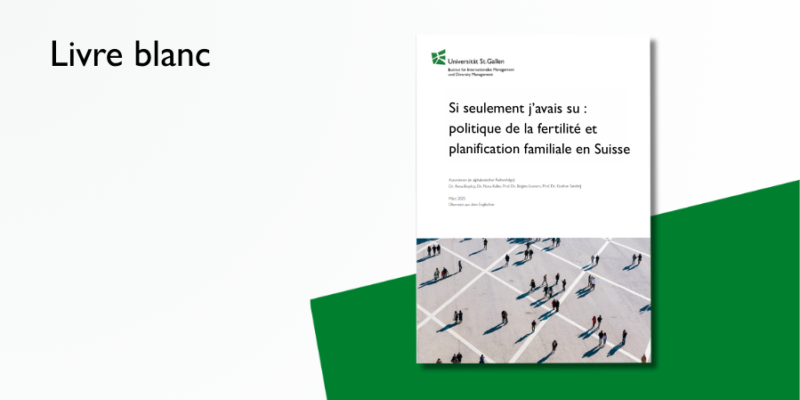
Paternity leave is a win-win-win for families, organizations and society
Categories
CareerThis article is also available in German.
The research is clear: Equitable parental leave is as close as possible to a panacea to inequalities in parents’ involvement in care and paid work. Thus, paternity leave is good for everyone. However, there are important caveats: Not all parental leave is created equal, pun fully intended. What are some important “do’s” and “don’t’s” to keep in mind?
Per April 1, Alliance F together with other committed stakeholders launched the signature collection for a popular initiative to replace the current maternity and paternity leave policies in Switzerland. With their initiative, “a strong society and economy thanks to parental leave (Family leave initiative),” they are calling for Switzerland to introduce 18 weeks of parental leave for each parent following the birth of their child.
Unsurprisingly, reactions have run the full gamut from wildly enthusiastic to deeply skeptical. Supporters hope that the initiative will lead to a rebalancing of gender roles within families and in the society at large, whereas with the current, unequal maternity and paternity leave policy, “stereotypical roles are perpetuated,” according to Dominik Elser, the managing director of the initiative. Alliance F stresses, among other factors, the positive effects on the child’s health and bond with the father.
On the other end of the spectrum: By equalizing parental leave, the initiative devalues the physical strain (and potential trauma) of pregnancy and birth on the female body, according to parliamentarian Katharina Prelicz-Huber. Others stress that the initiative doesn’t do justice to breastfeeding mothers, and that anyway, the traditional gender roles are too deeply entrenched to be meaningfully moved by the initiative. On the economic front, some criticize the negative impact on small and medium-sized businesses, and others, such as the Swiss Trade Association, expect deleterious effects on the economy.
That emotions run high around the topic of parental leave makes a lot of sense: This is a topic where the political is inherently very personal, and vice versa. With very personal topics, it can be difficult to see the woods for the trees, and as a professional researcher, it is in these moments that I turn to research. What are the effects of equitable parental leave (as proposed in the initiative) on gender (in)equality in paid and unpaid work? And what does the research tell us about the framework conditions necessary to make it a success?
The very direct link between paternity leave and work equity
Since the 1960s, there has been seismic change with women and mothers entering the (paid) labor market. However, men and fathers have not made the same change when it comes to a significant increase in (unpaid) care work. What role can equitable parental leave play in bridging this gap?
Research shows that “the birth of a child often reinforces an unequal division of employment and care work among heterosexual couples.” Imagine that the mother is the only parent at home with a child for the first few months or years of a child’s life, while the father (or second parent) keeps working as usual. In this case, the mother will set up the entire routine and know when and how the child eats, sleeps, and likes to play. She will know best how to soothe the child. She will know when the next pediatrician’s appointment is and when the family is likely to run out of baby formula. The family will develop a habit where the lion’s share of care work falls to her, where she carries most of the mental load.
Conversely, paternity leave allows fathers to set the foundation for an equal distribution of responsibilities in the future (for instance, getting kids to and/or from daycare). Patnaik (2019) found that even mere weeks of reserved paternity leave increased fathers’ participation in care work by 250%, and that these effects last long past the post-partum period. The positive association between fathers’ use of parental leave and more equal divisions of household tasks is confirmed in a plethora of empirical studies.
Paternity leave is very effective in setting up couples for long-term success when it comes to sharing care work and enabling both parents to engage in satisfying careers, as it sets up their dynamic outside the traditional gender roles of male breadwinner and female caretaker. If fathers take sizeable paternity leaves, this boosts women’s career continuity. Bacheron (2021) analyzed data from the European Union Labour Force Survey to study the impact of paternity leave policies on mothers' employment in ten countries and found that use of paternity leaves increased mothers’ employment rate by up to 17%.
From an employer perspective, this makes intuitive sense: Imagine you are hiring for a management role, and you have two short-listed candidates, a man and a woman in their early 30s. The rational choice might be to hire the man: After all, the woman might get pregnant, go on maternity leave, reduce her employment percentage. In fact, our own data, based on the HR data of 371’000 employees in Switzerland, show that men are nearly twice as likely to be hired for management roles in their 30s than women. By implementing equitable parental leave, you quite literally level the playing field.
Particularly noteworthy: Gender equity norms boosted by equitable parental leave are perpetuated across generations! Petts and Knoester find that, even nine years later, children whose fathers took at least two weeks of paternity leave after they were born reported feeling closer to their fathers than children with fathers who did not take leave. The positive effects of paternity leave are both consequential and long-lasting. Likewise, Farré and co-authors find convincing, quantitative evidence that by age 12, “children whose fathers were eligible for paternity leave exhibit more egalitarian attitudes towards gender roles and are more supportive of mothers and fathers being equally engaged in the labor market and in the home.”
You might be tempted to say: Just because fathers can take leave doesn’t mean they will, and that all of these putative positive effects are overblown. Switzerland isn’t ready for a fifty-fifty care split. But policy creates incentives, and, over time, can create social and normative change. Providing even the option for paternity leave signals that taking on a more equitable care role is acceptable. In fact, in all countries where paternity leave was increased, uptake increased significantly, too!
How (not) to implement equitable parental leave
Equitable parental leave is as close as possible to a panacea to inequalities in parents’ involvement in care and paid work. However, there are important caveats: Not all parental leave is created equal, pun fully intended. What are some important “do’s” and “don’t’s” to keep in mind?
- Reserve part of the leave for fathers (or non-birthing parents): Some countries (like Germany) subsume paternity leave in a general leave entitlement, leaving it up to the parents to split it between them. In Germany, this results in mothers taking an average of 15.5 months of parental leave, while fathers take only 3.4 months. To maximize fathers’ uptake of paternity leave, making it mandatory is the most efficient (but politically untenable) solution. Second best: Reserve a chunk of leave for fathers rather than giving parents the choice to divide it up between themselves, which studies show to be very effective in increasing fathers’ leave use.
- Maternity and paternity leave need to have similar lengths: Longer maternity leave is associated with setting up long-term inequalities in parents’ careers and involvement in family life, especially if there is also a considerable difference to paternity leave length. This is a key reason why it’s important to designate similar lengths for both parents in parental leave design.
- Supportive employers vastly increase fathers’ leave uptake: When fathers fear professional repercussions, they are less likely to take (longer) parental leave. This is both common sense and shown very clearly in various empirical studies. Fathers working in the public sector are more likely to take parental leave than fathers in the private sector, men working in larger companies are more likely to take their leave than men working in smaller companies, and fathers with management responsibility are less likely to take parental leave. Men working in female-dominated fields (education, nursing, etc.) are more likely to take their full leave than men working in male-dominated professions, such as banking.
Thus: Workplaces play a crucial role in supporting fathers in leave taking and should do all they can to signal that they are supportive of fathers “sharing the care”. A particularly effective way is to give visibility to role model leave-taking fathers, especially ones in management. Finally, the state needs to provide the (financial, administrative, logistical) support necessary so that companies of all sizes and sectors can afford paternity leave.
Best of all? Change is possible. If studies/research show anything, it's that well-designed policies can change behavior and break cycles of inequality, as we've seen in countries that have adopted equal parental leave. Now it's up to Swiss society to decide if it's ready to take that step.





